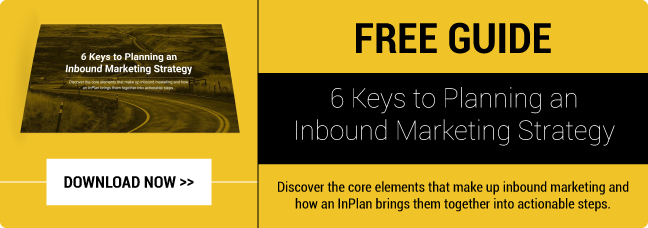
Your dental practice might not see as many new patients as you like and your profits aren't increasing. While you might be tempted to point the finger at everything from the economy to your competitors, the real problem often comes from your current online marketing strategies.
You have too much to do on a daily basis, from performing dental implant surgeries to managing your practice, and you don't have the digital marketing expertise to know which strategies attract new patients or how to create a coordinated strategy. When you don't have a dental practice marketing plan ready, you're going to run into four big problems.
Download our free guide here for tips on planning an online marketing strategy to grow your dental practice.
1. No Website Traffic to Attract New Dental Patients
Every digital marketing guide out there tells you to get a website, but what they fail to explain is how to consistently attract enough relevant traffic to it and the elements required for a high conversion site. You don’t have a chance to turn visitors into leads/enquiries without enough website traffic volume
2. Ineffective Blogging
The Content Marketing Institute reports that 77 percent of businesses use blogging for their marketing efforts. You will encounter a big difference between setting up a blog and creating a highly successful lead generation tool for your dental practice. You may not have the time to create content for your blog or manage a writer to do it for you. When these blog posts don't bring in the search engine traffic they should, potential patients click away from the site due to a lack of engaging content.
3. High Dental Patient Acquisition Cost
Paid digital advertising options, such as PPC, require significant expertise to see a top performing ROI. If you don't know what you're doing, you drive up your customer acquisition cost due to PPC spending. Your advertising and marketing budget quickly becomes unsustainable without giving you the results you expect.
4. No Brand Awareness
Your competitors may have years of exposure to the potential dental implant audience in your area. You start off with no brand awareness, so your messages fall on deaf ears.
How to Fix Your Dental Practice Marketing Problems
These four problems follow a common theme: You spend too much time reaching out to an audience that may not be interested in your services, and not enough time on efforts designed to attract new high value patients to your dental practice. You need an inbound marketing plan to bring in more website visitors, increase your conversion rates and ultimately attract more new dental patients.
Your online marketing strategy must start with an inbound marketing plan.
Inbound marketing uses interesting content to stand apart from other dental practices, improve your search engine position and bring interested patients to you. You use high-quality blog posts, social media, infographics, podcasts, videos, ebooks and other types of valuable content to build trust, authority and brand awareness.
You aren't shouting your message from the rooftops to everyone listening. Instead, your content generates patient interest in your company.
These self-selecting prospects bring in better-qualified leads who are better educated and ready to continue their buyer's journey. Your online marketing strategy must start with an inbound marketing plan.
Creating Your Online Marketing Plan
Your inbound marketing plan (we call it an InPlan) creates a solid foundation for your efforts. Without this plan, you'll find it difficult to make an efficient system for bringing in more new dental patients and improving your dental practice's brand awareness. You have four critical areas to focus on when you put your plan together:
- Your current marketing situation
- Your ideal customers
- Your marketing engine
- Your content roadmap.
1. Situational Assessment
Your first InPlan step focuses on a situational assessment. Take a look at your current marketing and advertising methods. If you have analytics data available on each strategy's effectiveness, make a note of this information. What marketing assets do you have available? You may have content available for inbound marketing repurposing, which decreases your production requirements. Finally, establish your dental practice goals for this plan. Do you want to focus on improving your patient lead volume or increasing patient education on your services? Your goals may change over time, but you want to start with a core mission in mind. If you have no data or information on your marketing then just start with realistic goals of what you would like to achieve in the next 3 months and use those as your benchmarks
2. Identify Ideal Patients
A one size fits all inbound marketing approach fails to bring in the perfect patients for your dental practice. If you can attract more new dental patients that you want to work with, you will ultimately spend less time performing treatments that are not profitable and more time enjoying life.
A buyer persona establishes a profile of your ideal customer. You use demographic information such as age, income level and life stages to create a comprehensive background. You consider the types of challenges this patient faces with their dental needs and their priorities when it comes to their care. For example, your high value patient focuses more on the value of the treatment and quality of service over pricing. Your marketing and advertising efforts use messaging designed to attract this particular persona, instead of taking a catch-all approach.
3.Build the InEngine

You might struggle with fitting marketing activities into your busy dental practice schedule. So systematically work from the bottom of the InEngine pyramid (your inbound marketing engine) and focus on the marketing functions you realistically can achieve with your resources and time available. Start with blogging & website first if you have no formalised functions in place and go from there, there is no need to delay to try to add all the functions at once, you can still attract more dental patients with these 2 elements as a start.
However, do set out a time frame to implement all functions in the InEngine as this will get you to the most efficient online marketing strategy that helps you turn your website visitors into qualified leads ready to walk into your dental practice while freeing up your time.
4. The Content Roadmap
Your content plays a key role in your inbound marketing plan. Stay away from generic content and focus on what your ideal customers look for when they search for a dental practice. Consult with your team, look at your website search queries and reach out to current patients to create a list of common questions. Your content roadmap must address these topics and tie each to a specific stage in the patient's journey.
You don't see immediate results with inbound marketing, but this long-term online marketing strategy establishes a sustainable plan for generating business and positioning your practice for long-term success.
Get Planning first to attract more new dental patients
Before you implement anymore marketing tactic ensure your plan strategy is sound as this will ultimately determine the success of your marketing efforts and more importantly, you will know why it worked or didn't so you can repeat or reiterate the process. Follow these steps to bring in more new dental patients and increase your profits.
.png?width=694&height=280&name=YVD%20Branding_Logo%20(WHITEBG).png)

